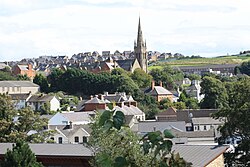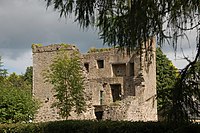Downpatrick
| Downpatrick Scots: Dounpatrick | |
| County Down | |
|---|---|
 Downpatrick | |
| Location | |
| Grid reference: | J485447 |
| Location: | 54°19’19"N, 5°42’11"W |
| Data | |
| Population: | 10,316 (2001) |
| Post town: | Downpatrick |
| Postcode: | BT30 |
| Dialling code: | 028 |
| Local Government | |
| Council: | Newry, Mourne and Down |
| Parliamentary constituency: |
South Down |
Downpatrick is a medium-sized town in County Down about 20 miles south of Belfast. It is the county town. It is a town with a rich history and claims a strong connection to Saint Patrick, after whom it is named, the town's name is from Dún meaning "stronghold", to which the missionary saint's name has been added.
Overview
Downpatrick is the largest town in the Lecale area. It is a commercial, recreational and administrative centre for the locality and serves as a hub for the nearby towns and villages. Within an hour drive of Belfast, the location serves as a commuter town for a large number of people. The town has a number of primary and post-primary schools educating students from all over the east Downshire area.
Geography
Downpatrick is characterised by the rolling drumlins that are a feature of the Lecale area and a legacy of glaciation during the Pleistocene, the Down drumlins themselves are underlaid by Ordovician and Silurian shales and grits. It also has the distinction of being the lowest place on the island of Ireland, with the marsh surrounding the north east of the town recorded as being 1.3 feet below sea level.
History
Pre-history
An early Bronze Age site was excavated in Downpatrick on the Meadowlands housing estate, revealing two round houses. One measured over four metres in diameter and contained a hearth in the centre, while the other round house was over seven metres across.[1]
Early history
Downpatrick is one of Ireland's most ancient and historic towns. It takes its name from a dún (fort), which once stood on the hill that dominates the town and on which Down Cathedral stands. Ptolemy, about the year AD 130, includes it (in Latin) as Dunum in his list of towns of Ireland. The old name of the town was Rath Celtair named after the fictional warrior of Ulster called Celtchar (in modern Irish: Cealtachair) who resided there and who fought alongside Ulster King Conchobar mac Neasa and is mentioned in the Ulster Cycle and, in particular, the Táin Bó Cuailgne. The name was superseded by the name Dún Lethglaise then Dún Dá Lethglas which in turn gave way, in the 13th century, to the present name of Downpatrick, from the town's connection with the patron saint of Ireland.
Saint Patrick was reputedly buried here in 461 on Cathedral Hill, within the grounds of Down Cathedral. His grave is still a place of pilgrimage on St Patrick's Day (17 March each year). The Saint Patrick Visitor Centre in Downpatrick is purpose-built to tell the story of St Patrick.
County Down was the ancient centre of the Dál Fiatach lands, and the chief royal site and religious centre of the Dál Fiatach was at Downpatrick.
In 1137, Malachy became the the first Bishop of Down, resigning as Archbishop of Armagh, having separated the two dioceses and appointed another as Bishop of Connor. He administered the diocese of Dún dá leth glas (Down) from Bangor and introduced a community of Augustinian canons to the town dedicated to St John the Evangelist, and repaired and enlarged Down Cathedral.
After having received a grant of Ulster from King Henry II of England, Sir John de Courcy set out from Dublin in early 1177 to take possession of it. He marched north to with a force of 20 knights and 300 men and reached Downpatrick four days later. Downpatrick was an open ecclesiastical town of the old type and the invaders rode in and surprised it in the small hours of February 2. De Courcy attacked the fortress and administrative centre of Rath Celtair (the Mound of Down), defeating and driving off Rory MacDonlevy (Ruaidhri Mac Duinnshleibhe), King of the Dál Fiatach.
In 1183, John de Courcy brought in some Benedictine monks from the Abbey of St Werburgh in Chester (today Chester Cathedral) and built a cathedral friary for them at Downpatrick. This building was destroyed by an earthquake in 1245.[2]
In 1260 Brian O'Neill, King of Tír Eoghain and who had been acknowledged as High King of Ireland by Hugh O'Conor of Connaught and Tadhg O'Brien of Thomond marched to Downpatrick, a centre of English settlement, and, allied with a Connaught force under Hugh O'Conor, fought the settlers in the Battle of Down, which took place outside the city of Down. O'Neill, eight Connaught lords and many others died.
18th Century
Four main thoroughfares are shown converging on a town plan of 1724, namely, English Street, Scotch (now Saul) Street, Barrack (now Scotch) Street, and Irish Street. Topography limited expansion of the town and so the basic early 18th century street plan continued largely unchanged until 1838 when Church Street was built, followed by Market Street in 1846.
The condition of the town was greatly improved in the 18th century by a land-owning family named Southwell. The first Edward Southwell was responsible for building a shambles in 1719 and encourage paving of the streets which started in 1727. Importantly, in 1717 he built a quay and grain store at Quoile Quay, thereby, contributing to the economic expansion of the town. The second Edward Southwell was responsible for building, in 1733, one of the most beautiful examples of a Georgian charity school and almshouse, Southwell School, Downpatrick.
Down County Infirmary was established in a house in Saul Street in October 1767, and remained there for seven years until it was moved to Barrack Lane (now Fountain Street) where the former Horse Barracks, was purchased, in 1774, for £150 for use as the Infirmary. It was used until the new Infirmary (now the Downe Hospital) was opened in 1834.
In June 1778, John Wesley, the founder of Methodism famously preached both in the new preaching house in Downpatrick and in The Grove beside the ruins of Down Cathedral which he called a "noble ruin".
19th Century
On 21 October 1803, co-founder and leader of the United Irishmen, Thomas Russell, "the man from God knows where", was hanged outside Downpatrick Goal for his part in Robert Emmet's failed rebellion of the same year. Thomas Russell is buried in the graveyard of the Anglican parish Church of Downpatrick, St Margaret's, in a grave paid for by his great friend, Mary Ann McCracken sister of leading Belfast United Irishman, Henry Joy McCracken.
Sights about the town


- Ballyalton Court Cairn is a single court grave situated on a rock outcrop by the roadside ½ mile from Ballyalton village, which is 2¼ miles east of Downpatrick.[3]
- Ballynoe Stone Circle, a large circle of over 50 closely-spaced upright stones, surrounding a mound which, when excavated, was found to contain two cists in which cremated bones were found, is only 2½ miles south in the hamlet of Ballynoe. The site is near the disused railway station, reached by a long footpath off the main road, at grid ref: J481404.[4]
- Downpatrick Racecourse, is located on the Ballydugan Road on the outskirts of Downpatrick. Horse racing has been held at Downpatrick under the charter of King James II.
- [ Inch Abbey], a large, ruined Cistercian monastic site featuring early Gothic architecture is ¾ of a mile north-west of Downpatrick on the north bank of the River Quoile off the main road to Belfast, at grid ref:.
- The Lecale peninsula covers an area of some 78 square miles between Downpatrick and Dundrum, County Down|Dundrum. It is an area of historical and geographic significance.
- The Mound of Down or Rathkeltair is one of the major earthworks of Ulster, situated on the NW edge of Downpatrick it is a good example of an Iron Age defensive earthwork in the middle of which a Norman motte and bailey was built by John de Courcy after his defeat of Rory Mac Donlevy in 1177. Some believe that it was the residence of Celtchar mac Ulthechair, the legendary Iron Age hero of the Ulster Cycle. It seems to have become the administrative centre of the Kings of Dál Fiatach by the early Christian period.
- St Patrick Centre, is the only permanent exhibition in the world dedicated to the patron saint of Ireland.
- [ Quoile Castle] is a ruined 16th century tower house, just off the main road from Downpatrick to Strangford.
- [ Struell Wells] is a set of four holy wells 1½ miles east of Downpatrick.[5] The wells date from before the time of Saint Patrick, and even today are used for people seeking cures.[6]
Picture gallery
-
Downpatrick, October 2009
-
Down Cathedral
-
Reputed grave of St. Patrick
References
- ↑ Mallory, JP & McNeill, TE (1991). The Archaeology of Ulster from Colonization to Plantation. Belfast: Institute of Irish Studies, QUB. pp. 95.
- ↑ DeBreffny, D & Mott, G (1976). The Churches and Abbeys of Ireland. London: Thames & Hudson. pp. 60–61.
- ↑ Evans, E (1966). Prehistoric and Early Christian Ireland. A Guide. London: BT Batsford. pp. 93–94.
- ↑ Department of the Environment for Northern Ireland (1983). Historic Monuments of Northern Ireland. Belfast: HMSO. pp. 88.
- ↑ Department of the Environment for Northern Ireland (1983). Historic Monuments of Northern Ireland. Belfast: HMSO. pp. 113–114.
- ↑ Donnelly, JP & Donnelly, MM (1980). Downpatrick and Lecale. A Short Historical Guide. pp. 42–43.
Outside links
| ("Wikimedia Commons" has material about Downpatrick) |



